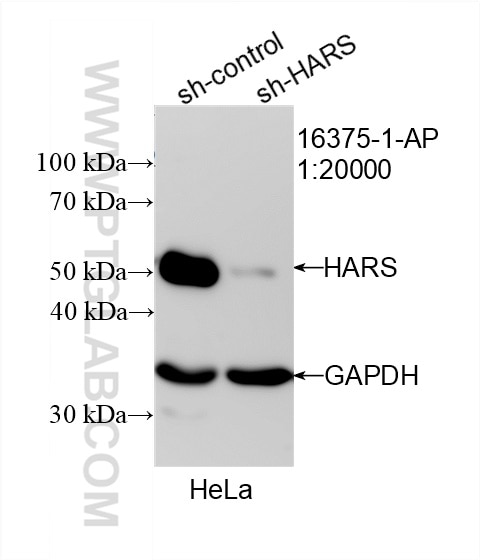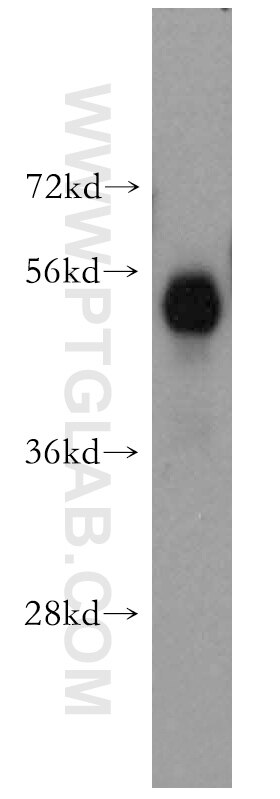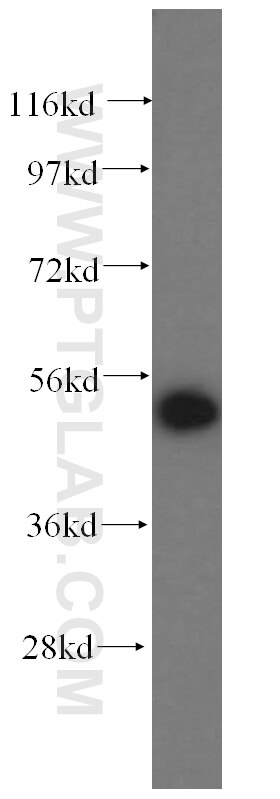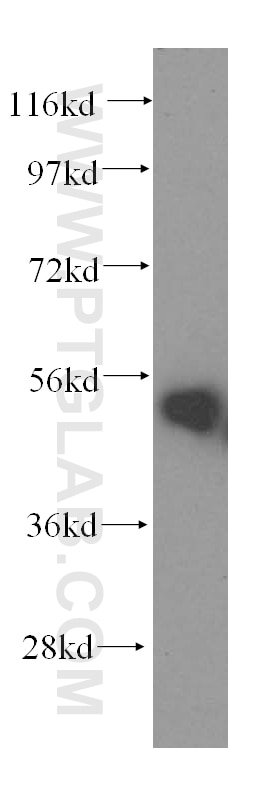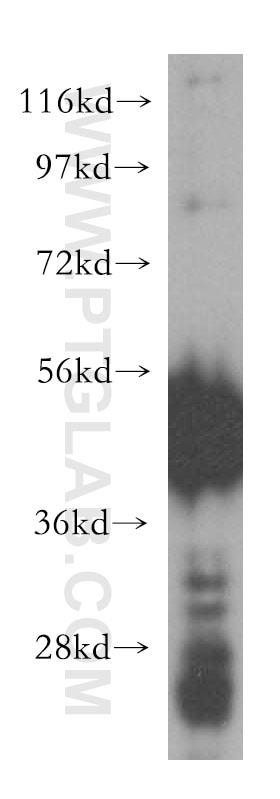Validation Data Gallery
Tested Applications
| Positive WB detected in | mouse liver tissue, HeLa cells, human kidney tissue, K-562 cells, mouse brain tissue, mouse heart tissue, mouse lung tissue |
| Positive IHC detected in | human stomach tissue Note: suggested antigen retrieval with TE buffer pH 9.0; (*) Alternatively, antigen retrieval may be performed with citrate buffer pH 6.0 |
Recommended dilution
| Application | Dilution |
|---|---|
| Western Blot (WB) | WB : 1:500-1:1000 |
| Immunohistochemistry (IHC) | IHC : 1:50-1:500 |
| It is recommended that this reagent should be titrated in each testing system to obtain optimal results. | |
| Sample-dependent, Check data in validation data gallery. | |
Published Applications
| WB | See 6 publications below |
Product Information
16375-1-AP targets HARS in WB, IHC, ELISA applications and shows reactivity with human, mouse, rat samples.
| Tested Reactivity | human, mouse, rat |
| Cited Reactivity | human, mouse |
| Host / Isotype | Rabbit / IgG |
| Class | Polyclonal |
| Type | Antibody |
| Immunogen |
CatNo: Ag9333 Product name: Recombinant human HARS protein Source: e coli.-derived, PGEX-4T Tag: GST Domain: 1-282 aa of BC011807 Sequence: MAERAALEELVKLQGERVRGLKQQKASAELIEEEVAKLLKLKAQLGPDESKQKFVLKTPKGTRDYSPRQMAVREKVFDVIIRCFKRHGAEVIDTPVFELKETLMGKYGEDSKLIYDLKDQGGELLSLRYDLTVPFARYLAMNKLTNIKRYHIAKVYRRDNPAMTRGRYREFYQCDFDIAGNFDPMIPDAECLKIMCEILSSLQIGDFLVKVNDRRILDGMFAICGVSDSKFRTICSSVDKLDKVSWEEVKNEMVGEKGLAPEVADRIGDYVQQHGGVSLVEQ 相同性解析による交差性が予測される生物種 |
| Full Name | histidyl-tRNA synthetase |
| Calculated molecular weight | 509 aa, 57 kDa |
| Observed molecular weight | 50 kDa |
| GenBank accession number | BC011807 |
| Gene Symbol | HARS |
| Gene ID (NCBI) | 3035 |
| RRID | AB_2116283 |
| Conjugate | Unconjugated |
| Form | |
| Form | Liquid |
| Purification Method | Antigen affinity purification |
| UNIPROT ID | P12081 |
| Storage Buffer | PBS with 0.02% sodium azide and 50% glycerol{{ptg:BufferTemp}}7.3 |
| Storage Conditions | Store at -20°C. Stable for one year after shipment. Aliquoting is unnecessary for -20oC storage. |
Background Information
HARS is a cytoplasmic enzyme that belongs to the class II family of aminoacyl-tRNA synthetases. The enzyme is responsible for the synthesis of histidyl-transfer RNA, which is essential for the incorporation of histidine into proteins. HARS is located in a head-to-head orientation with HARSL on chromosome five, where the homologous genes share a bidirectional promoter. The gene product is a frequent target of autoantibodies in the human autoimmune disease polymyositis/dermatomyositis. The D364Y (Asp364-to-Tyr) mutation of HARS1 inhibits morphological differentiation of neuronal cells (PMID: 35380399).
Protocols
| Product Specific Protocols | |
|---|---|
| IHC protocol for HARS antibody 16375-1-AP | Download protocol |
| WB protocol for HARS antibody 16375-1-AP | Download protocol |
| Standard Protocols | |
|---|---|
| Click here to view our Standard Protocols |
Publications
| Species | Application | Title |
|---|---|---|
Nat Cell Biol Leucyl-tRNA synthetase is a tumour suppressor in breast cancer and regulates codon-dependent translation dynamics. | ||
Mol Cell A methyltransferase-independent role for METTL1 in tRNA aminoacylation and oncogenic transformation | ||
Sci Rep NRF2 activation ameliorates blood-brain barrier injury after cerebral ischemic stroke by regulating ferroptosis and inflammation | ||
Front Pharmacol S1PR3, as a Core Protein Related to Ischemic Stroke, is Involved in the Regulation of Blood-Brain Barrier Damage. | ||
BMC Med Genomics Analysis of ferroptosis-related genes in cerebral ischemic stroke via immune infiltration and single-cell RNA-sequencing | ||
Neuroscience MyD88 inhibition attenuates cerebral ischemia-reperfusion injury by regulating the inflammatory response and reducing blood-brain barrier damage |


